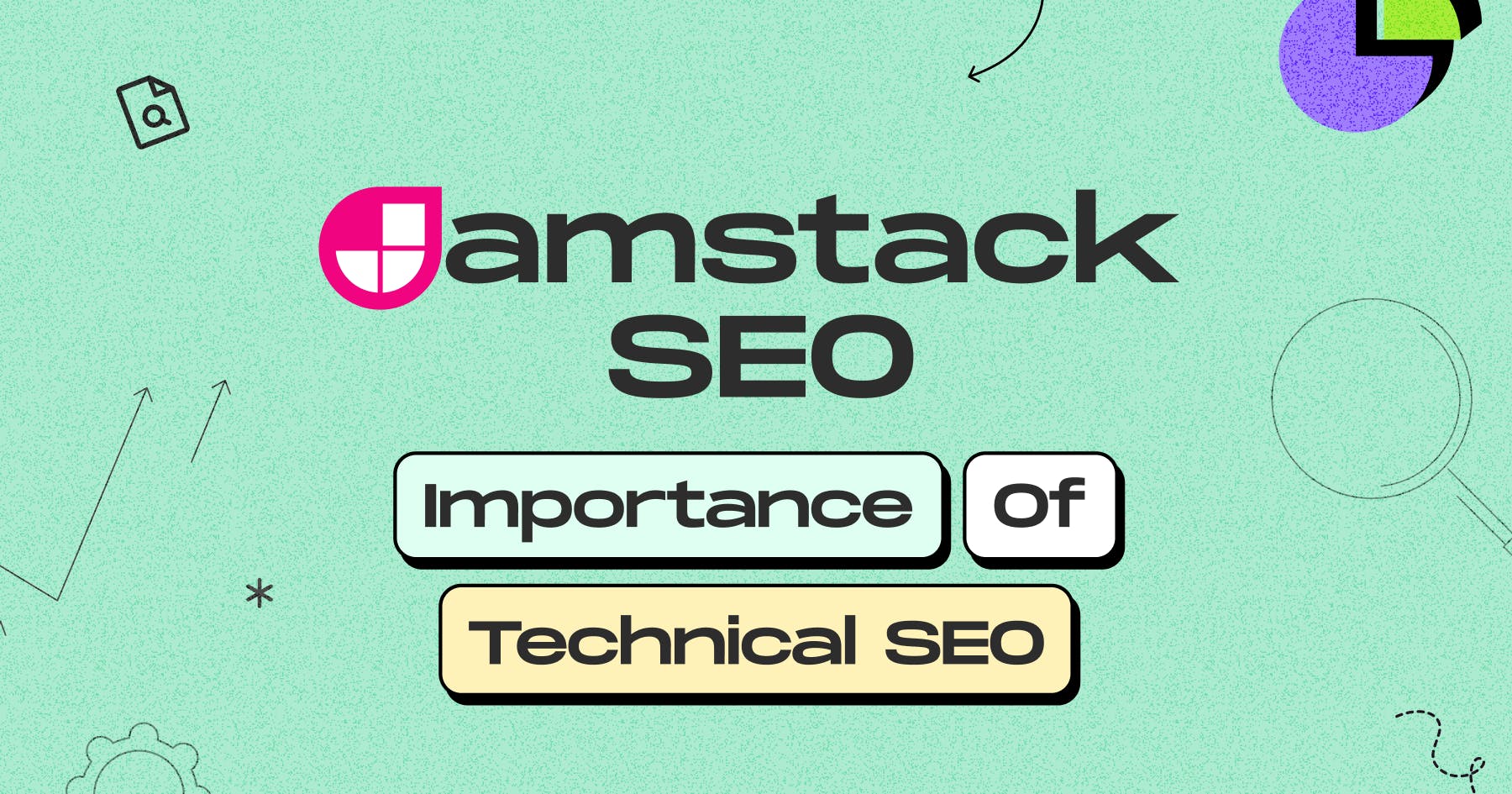March 30, 2023
Jamstack SEO: Importance of Technical SEO

Nusrat Sarmin

Welcome to the ultimate guide to technical SEO for JAMStack! As more and more web development teams are turning to “JAMStack” architecture, it’s important to understand how to implement SEO strategies on Jamstack sites. This Jamstack Technical SEO guide will provide a comprehensive overview of the fundamentals of technical SEO. But this is not enough. Along with this, content SEO should be given equal attention.
First, let's start with the basics.
What is Technical SEO?
A crucial part of any SEO plan is technical SEO. Technical SEO is a process of optimizing a website's technical components in order to boost its ranking on search engines. It involves implementing various strategies and tactics to ensure that a site is properly indexed, crawled, and ranked by search engines.
Additionally, Technical SEO improves websites’ search engine friendliness and includes activities aimed at improving the user experience.
It includes activities such as improving page load speed, making sure there are no crawl errors or broken links, ensuring indexable content is present on the page, and more.
JAMstack Technical SEO
Before we get into Jamstack technical SEO, it’s important to understand what JAMStack is. JAMStack stands for JavaScript, APIs, and Markup. It’s a modern web development architecture that uses pre-built components created with JavaScript, APIs, and markup languages like HTML and CSS.
The advantages of a JAMStack site are that it’s incredibly fast, secure, and provides a great user experience. Jamstack static web pages are very light-weight & SEO-friendly while Jamstack offers many advantages over traditional web architectures, it also brings some unique benefits when it comes to SEO.
Aye, Jamstack sites can be built to be more SEO-friendly by following best practices. Such as making sure all content is crawlable, utilizing structured data, responsive design, optimizing URLs, implementing lazy loading, and creating an XML sitemap, you can ensure that your Jamstack site is optimized for search engines.
Why Is Technical SEO Important?
Technical SEO is important because it helps ensure that your website can be found, indexed, and ranked by search engines. Without proper implementation of technical SEO practices, your website may not be indexed, or worse, it could be penalized by search engines and lose visibility in the SERPs. Technical SEO is also important for improving page speed, site structure, and user experience, which are all key factors in how well a website ranks.
What Are the Factors of Technical SEO?
Improving your technical SEO involves understanding the different elements of technical optimization and taking steps to optimize them.
Here are some key technical SEO factors and best practices that will help ensure your Jamstack site is properly indexed and ranks well in SERPs.
Web Performance
Web performance refers to the speed and efficiency of a website. It encompasses various factors, such as page load time, server response time, and other metrics that affect how quickly a website responds to user requests. Good web performance is essential for providing a positive user experience, reducing bounce rates, and improving search engine rankings.
Page Experience
Page experience refers to how users perceive and interact with a website. It includes various factors such as the speed of the site, responsiveness, interactivity, security, and usability. Google has announced that it will be incorporating page experience as a ranking factor in its algorithm starting in May 2021.
The criteria used to evaluate page experience are Core Web Vitals, Mobile usability, and HTTPs usage.
Core Web Vitals
Core Web Vitals is a set of metrics that Google uses to measure and evaluate website performance. These metrics focus on the user experience, including page speed, interactivity, and visual stability. Core Web Vitals are incorporated into Google's algorithm as a ranking factor, so it's essential for website owners to pay attention to these metrics.
There are three Core Web Vitals that website owners should focus on…

1. Largest Contentful Paint (LCP): This metric measures how long it takes for the largest content element on the page to load. Ideally, LCP should occur within 2.5 seconds of when the page starts loading.
2. First Input Delay (FID): FID measures how long the website responds to user interaction, such as clicking a button or filling out a form. A good FID score is less than 100 milliseconds.
3. Cumulative Layout Shift (CLS): CLS measures how much the page layout shifts during loading. A low CLS score means that elements on the page remain stable during loading.
Mobile-friendly
Websites that are mobile-friendly are designed to provide a positive user experience on smaller screens such as smartphones and tablets. With more people accessing the internet through their mobile devices, it's essential for website owners to ensure that their site is optimized for mobile users.
HTTPS
Another important aspect of SEO is using HTTPS. HTTPS is a secure version of HTTP that encrypts data between the website and the user's browser.
Ways to Improve Web Performance and Page Experience Score
1. Minimize HTTP Requests:
Minimizing HTTP requests means reducing the number of resources (such as images, scripts, and stylesheets) that your page needs to load.
2. Optimize Images
Images are often the largest files on a webpage, so optimizing them can have a big impact on web performance.
3. Optimize Page Speed
Page speed is a crucial factor in both user experience and SEO. Use tools like Google PageSpeed Insights to identify areas of improvement.
4. Use Responsive Design
Responsive design allows your website to adapt to different devices and screen resolutions, ensuring a great user experience across all devices.
5. Focus on User Experience
Ensure that your Jamstack site is easy to navigate, has clear and concise content, and provides value to the user.
6. Site Structure
The structure of your website should be logical and intuitive for users to navigate. Your homepage should provide a clear overview of your site's content and make it easy for users to access different sections of your site. Use categories and subcategories to organize your content into easily digestible chunks.
7. Standard Navigation
Your website's navigation should be simple and easy to use. Make sure that all important pages are accessible from the main menu or footer links.
8. JavaScript optimization
Excessive use of JavaScript can slow down page load times and negatively impact SEO. It's recommended to minimize the use of JavaScript and optimize it for performance
9. Utilize Content Delivery Networks (CDNs)
Choosing a fast and reliable hosting provider is crucial to Jamstack Technical SEO. Look for a hosting provider that offers high-speed servers, solid-state drives (SSDs), and scalable resources. You should also consider the location of the server in relation to your target audience to reduce latency and improve page load times. Remember, a slow-loading site can negatively impact both user experience and SEO rankings.
10. Use a Fast DNS Provider
Look for a DNS provider with fast query times and a global server network. Cloudflare and Google Cloud DNS are popular options that offer fast and reliable service.
Indexing and Crawlability
Indexing and crawlability are crucial for ensuring that search engines can properly find and rank your website. Crawlability and indexability refer to how easily a search engine can access your web pages, understand their content, and add them to their database for users to find. In order for this to happen, there needs to be a clear pathway for search engine bots to access your site's content. This is called crawlability. Once the search engine has accessed the page, it must then be able to interpret and understand it, which is known as indexability.
For a website to be indexed by search engines, it must have proper crawl ability and indexability. Crawlability involves ensuring that all of your website's pages are accessible by search engine bots via links from other sites or through XML sitemaps. Indexability involves ensuring that the content is structured so that search engine bots can easily understand it and index it accordingly.
Here are some tips to improve your site's indexing and crawlability.
1. Create a sitemap: A sitemap is a file that lists all the pages on your website. Submitting a sitemap to search engines like Google can help them crawl and index your site more efficiently.
2. Use structured data: Structured data provides additional context about the content on your website, making it easier for search engines to understand what your pages are about. Use tools like Schema.org to add structured data to your site.
3. Ensure proper URL structure: URLs should be descriptive and easy to read, using keywords related to the page's content. Avoid using long strings of numbers or characters in URLs.
4. Optimize meta tags: Meta tags provide information about a web page, including its title, description, and keywords. Use relevant keywords in these tags to help search engines understand what your page is about.
5. Fix broken links: Broken links can negatively impact crawling and indexing by preventing search engine bots from accessing certain pages on your site. Regularly check for broken links and fix them promptly.
Jamstack Technical SEO Tips from SEO Geeks
- Start with a website audit - A good place to start is to identify any existing problems that may be impacting your site’s SEO performance
- Optimize your page titles and meta descriptions - Ensure your page titles and meta descriptions are optimized for the keywords you want to rank for.
- Improve your site structure - It’s important that search engine crawlers can easily find all of your pages when they come to index them, so make sure your site structure is easy to navigate and logical.
- Optimize images - Images can play a huge part in technical SEO, making sure your page loads quickly and efficiently.
- Utilize Schema markup - Schema markup is a type of code that can be used to add extra information to your pages which helps search engines understand the content better.
- Ensure your website is mobile-friendly
- Utilize Rel Canonical tags - If you have multiple versions of the same page, you can use rel canonical tags to direct search engine crawlers to the version you want them to index
Over to You
Search engines are the main source of traffic for most websites, so it's essential to optimize your website for them. Technical SEO is an important part of that process. When done correctly, SEO can help boost a website’s rankings on search engine result pages (SERPs), increase traffic, attract more potential customers, and increase sales.
Unlock the full potential of your Jamstack website with the charm of Technical SEO - the art of making your online presence irresistible to search engines!
Heads Up! Mastering SEO is a journey, not a one-day hike. You've got to invest your time, sweat, and a bit of experimentation to conquer this digital mountain. Hope this guide helps you get a better insight into the different aspects of Jamstack technical SEO.

